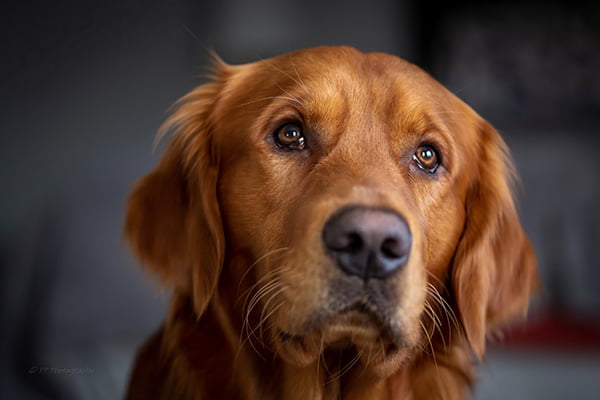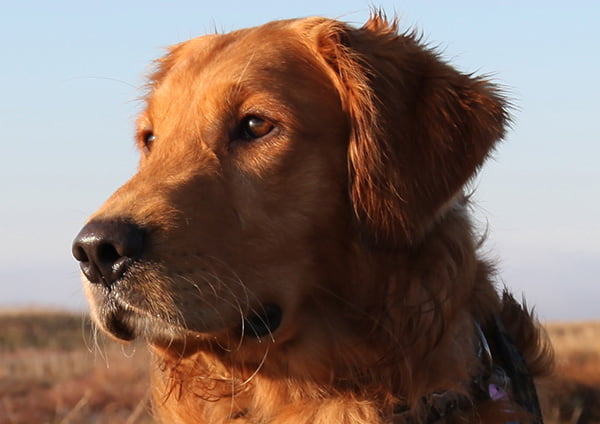Have you ever seen a red golden retriever? Their striking mahogany coats make a stunning statement, and like their standard golden friends, they have the most winning personalities of almost any other dog breed.
So what sets a red golden retriever apart, and how do you know if it is the dog for you?
Breed Characteristics
Temperament | Friendly, outgoing |
Intelligence | High |
Affection/Friendliness | Very affectionate |
Trainability | Highly trainable |
Mental Stimulation | High |
Exercise Needs | High |
Apartment Living | Not recommended |
Family Friendly | Yes |
Pet Friendly | Yes |
Drooling Level | Moderate to high |
Energy Level | High |
Loneliness Tolerance | Low |
Adaptability | Moderate |
Tendency to bark | Moderate |
Origin Red Golden Retrievers
The Red Golden Retriever dog is really just a color variation of the standard Golden Retriever. However, the same genes that contribute to the deep red coat contribute to a few other physical differences. It is uncertain when the first Red Golden Retriever appeared. Whether red or dark red golden retrievers, they are all considered golden retrievers.
The origins of the Golden Retriever go back to Scotland in the mid-1800s. They were mainly bred for hunting purposes. The Golden Retriever could track and retrieve prey that was shot from guns with a longer range than the guns before.
A wavy-coated retriever was bred with a tweed water spaniel, and the first Golden Retrievers were created. Over the years of development, several other breeds were incorporated for increased hunting skills and stamina. One of these other breeds was the Irish setter. These red Irish setter genes are most likely where a red golden retriever gets its dark coat. As a recessive gene, Red Golden Retrievers, also known as Red Retrievers, are relatively rare.
While they are purebred golden retrievers, red golden retrievers are not qualified to be show dogs by the American Kennel Club (AKC) or the Kennel Club (KC). These clubs have strict show standards that only allow for light golden, golden, or deep golden. The red retriever has a variation of a deep golden coat, but it is too dark to be regulation standard.
Red golden retrievers also come from a slightly different line of Goldens. There are two primary golden retriever lines, those that were and are field bred and those that were and are conformation bred, or show dog stock. Field-bred goldens tend to be a bit smaller, leaner, and more athletic than conformation bred goldens, which are a bit larger and less active.

Breed Overview
Height: 23-24"
Weight: 65-75 lbs
Height: 21-22"
Weight: 55-65 lbs
Breed Group
Sporting
Life Span
10-12 years
Coat
Dense and water-resistant
Coat Length
Medium
Hypoallergenic
No
Shedding Level
Moderate to high
Red Golden Retriever Size
Most Red Golden Retrievers are a bit smaller than regular Golden Retrievers, and this is due to the same recessive gene that lends them their rich mahogany coat and due to the fact they are field bred goldens. Males reach heights of 23-24 inches and weigh between 65 and 75 pounds. Females are a bit smaller at 21-22 inches tall and between 55-65 pounds full grown.
Personality
The personality of a red golden retriever is the same as a standard Golden Retriever. They have sweet, devoted personalities and make smart, driven, and loving companions.
Golden Retrievers have one of the calmest and most affable personalities of any dog breed, which is why they are one of the most popular dog breeds in the US.

Source: Flickr
Appearance/Colors
Red Golden Retrievers have a deep red or dark golden coat color, as the red coloring comes from the genetic background of the Golden Retriever breed. They are leaner and smaller than standard Goldens and have a slightly shorter outer coat. And their red color does not fade with age as a typical Golden Retriever does.
Temperament
Goldens are beloved because of their wonderful, loving, sweet, smart temperaments, which make them perfect pets for just about anyone. Also, it makes them great service dogs, search and rescue dogs, or hunting and show dogs.
Golden retrievers are known for their soft mouths. Their soft mouth makes great with kids, even small children, and other household pets.
Red Golden Retriever is friendly with strangers and other dogs. Easy to train, which makes them excellent therapy dogs, service dogs, and search and rescue dogs. They are good pets for seniors or children and thrive as family pets or companions for singles.
Diet/Nutritional Needs
A dark red golden retriever has pretty typical dietary needs for a large-size dog. For specifics regarding the quantity of food, you should consult with your vet, who will be able to make a recommendation based on your red retriever's size, age, and activity levels.
Clean, fresh water should be available at all times, and treats should be kept to a minimum to prevent obesity.
Activity/Exercise Needs
Red golden retrievers are a bit more active than standard golden retrievers, so it is one of the main considerations when deciding if this is the breed for you.
You will need to provide daily exercise through walks, running or jogging, hikes, or trips to the dog park. Some goldens enjoy swimming and dog sports as well.
The red golden retriever will also need plenty of mental stimulation to prevent him from developing negative habits out of boredom. Puzzle toys, trick training, and interactive games like hide-and-seek can be a great way to challenge your red golden retriever.
Grooming Needs
Another slight difference between a standard Goldens and a Red Golden Retriever is that Red Golden Retrievers tend to have shorter outer coats.
Red Golden Retriever tends to shed a little less than a standard Golden Retriever. Even though they shed less, you should still commit to daily brushing to keep your dog's coat tangle free and to manage the shedding, but you may find that your red golden sheds a bit less.
You should trim their nails regularly and get into the habit of daily teeth brushing. Examine your red golden retriever's ears regularly for signs of irritation, debris, or infection. To maintain good ear health, do get into the habit of cleaning their ear with dog ear cleaning solutions.
Adaptability
Red golden retrievers are highly adaptable dogs, able to adjust to just about anywhere so long as they have their people. They love a house with a big yard to play in but can thrive in an apartment, too, provided they are getting sufficient exercise and attention. Red Golden Retriever puppies can be trained to get along with just about everyone and most other pets and animals.

Source: Flickr
Trainability
A Red Golden Retriever puppy is very easy to train. Not only are these smart and intelligent dogs, but they love to please their people and respond very well to positive training methods.
They are food motivated which makes for a pretty straightforward training process, though they do tend to be a mouthier breed and will need to be taught not to bite and to be gentle.
Golden Retriever puppies will chew on anything, so be sure to not only train them not to chew on household things but give them plenty of toys that are chew-appropriate. Socialize your puppy as soon as possible and continue to introduce it to new environments and people throughout its puppyhood to ensure that it is as calm and friendly as possible.
Life Expectancy
Red Golden Retriever lifespan is the same as standard Goldens. A healthy golden retriever can be expected to live 10-12 years.
Cost
Due to their rarity, you can pay as much as $3000 for a Red Golden Retriever puppy. If you are going to purchase one from a breeder, be sure to do your research and look for reputable breeders.
A Red Golden Retriever can be found at shelter and rescue groups. Therefore, it's best to check out these options first!
Potential Health Issues
The potential health issues for a red golden retriever are the same as those of a standard golden. Many of these conditions are hereditary and genetic and can be spotted early with sufficient health screenings. Reputable red golden retriever breeders will have health screenings of litter parents carefully before breeding to ensure the healthiest possible puppies. Always ask to see these records and discuss anything that could be a concern.
Hip and Elbow Dysplasia
This is a genetic condition that results in the malformations of the dog's joints. It can start as early as puppyhood.
Hypothyroidism
This condition affects the thyroid's ability to produce or relate certain hormones that regulate metabolism. It can lead to weight gain, skin or coat issues, and changes in behavior.
Eye Disorders
Common eye disorders in golden retrievers include progressive retinal atrophy (PRA), golden retriever pigmentary uveitis (GRPU), and distichiasis.
Cancer
Golden retrievers have a high probability of developing cancer, with rates as high as 60%, making it one of the highest rates for any dog breed. Types of cancer include hemangiosarcoma, osteosarcoma, lymphoma, and mast cell tumors.
